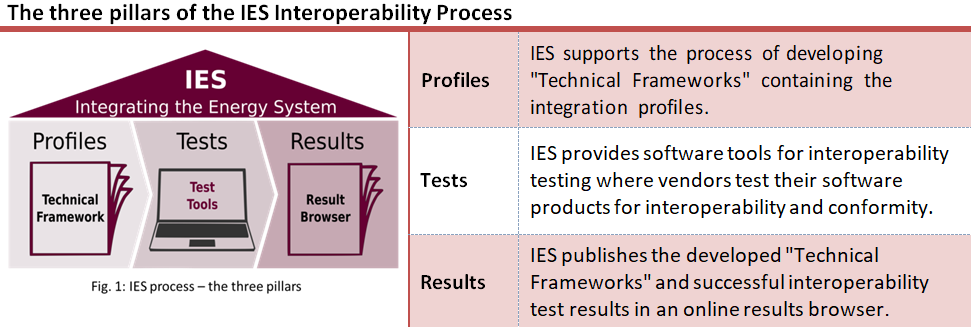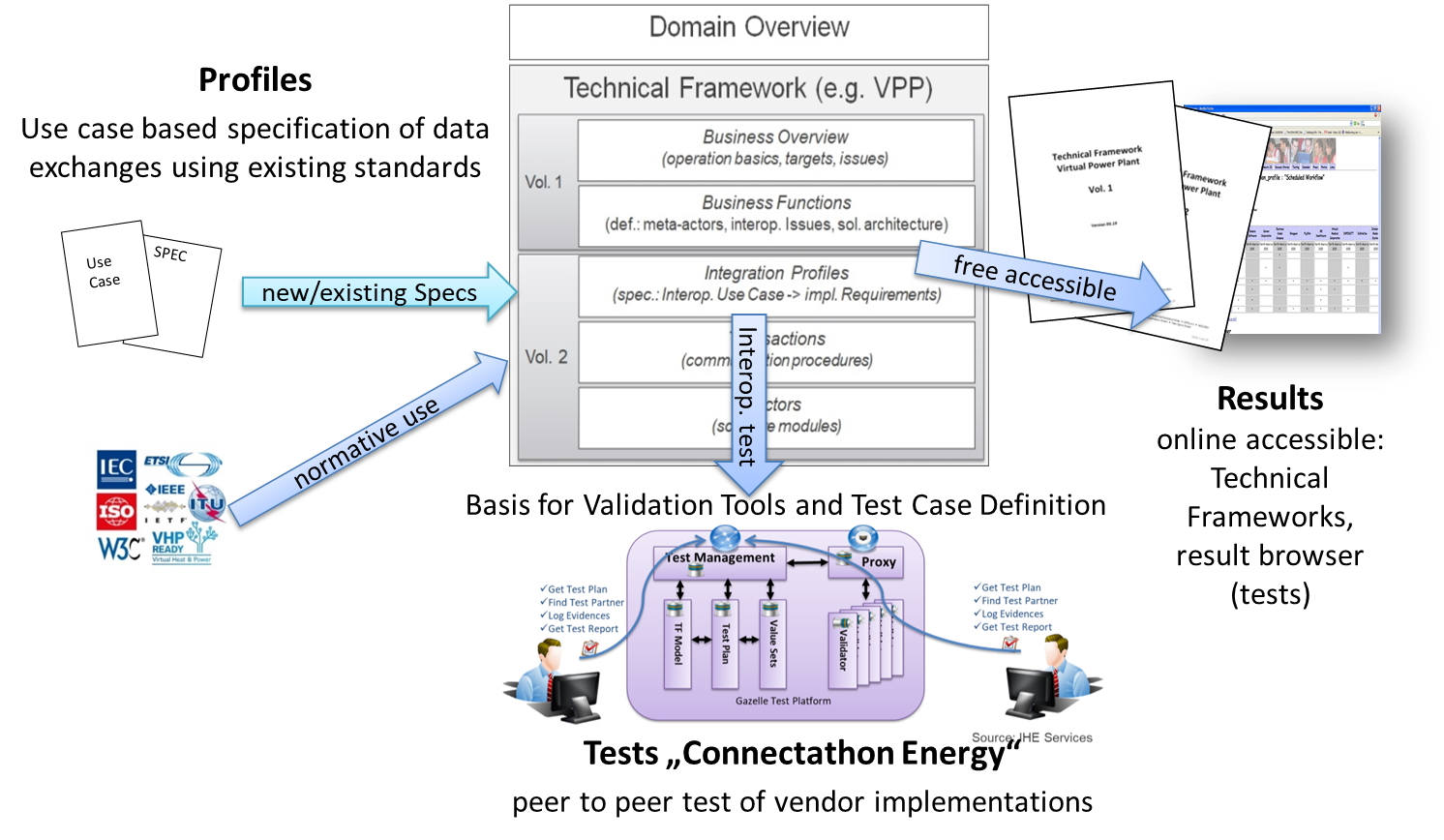The initiative IES – Integrating the Energy System
Interoperability is a key factor for the successful transition of the energy system.
The Initiative IES - Integrating the Energy System provides a common understanding and framework to develop and reuse solutions for data exchange: interoperability profiles instead of proprietary solutions. The transparency of the process ensures a sustainable investment protection for vendors and fosters competition, increases product quality and performance at lower costs.
Austria as a pioneer of interoperability in the energy sector
For the first time, the IES Austria project specifically addressed the issue of interoperability and developed a methodology and test facility for ICT systems in the energy sector. Relevant process know-how was developed for the specification of integration profiles, as well as for the test environment used for interoperability tests.
The test expertise for peer-to-peer interoperability tests in particular exists today in Austria and can lead to an advantage and international positioning in the international dissemination of the IES methodology for Austria. Austrian companies can benefit from this and position themselves as a provider of internationally relevant technologies and solutions early on and thus create high-quality jobs in F&E, production and service.
The IES-approach
The use of harmonized technical standards is a key requirement for cost-effective system integration. Communication standards allow certain flexibility in implementation, so interoperability can only be achieved through a normative application of these standards. This is done in the specification of so-called interoperability profiles
The IES methodology provides a transparent, manufacturer-neutral and cooperative process to define interoperability profiles and to test perform interoperability testing of ICT systems.
For this IES offers a tailor-made service offer for every step of the process chain. Domain experts are accompanied in a moderated process in the specification of interoperability profiles. Manufacturers who have implemented the public available interoperability profiles are supported in the preparation and implementation of interoperability tests.

The IES methodology can be used for any data exchange in digitalization.
The specification of the Technical Framework is the centre of the interoperability process (see Fig. 2)
In the first step of the process the Technical Framework is specified by experts starting with a concrete use case. The document structure is in line with Smart Grid Architecture Model (SGAM) and IEC 62559 Use Case Methodology.
The IES Initiative offers process support for the specification of the Technical Framework e.g. through moderated workshops where users and manufacturers jointly determine the requirements and functionalities.
In the second step, the Technical Frameworks are the basis for the test environment, which is made available by the interoperability process. The vendors receive tailor-made support for the preparation and implementation of the testbed.
The interoperability process provides that all the specifications are accessible online. The Initiative foresees the formation of a community that supports users and manufacturers in promoting the interoperable interconnection of ICT systems in the energy system.

Interoperability testing as key factor for system integration
Today, a broadly applicable peer-to-peer test facility is lacking, enabling early prototype testing to test for interoperability of ICT systems. The IES methodology provides the continuous process including interoperability and conformity tests for all stages of system integration. In order to exploit synergies, cooperation with similar European initiatives and testing laboratories will be sought in order to jointly address the challenges of the energy system.
Test Event Connectathon Energy
Part of the IES methodology is a test event “Connectathon Energy”, which provides a detailed implementation and testing process to enable the adoption of standards-based interoperability.
During a Connectathon Energy the vendors test their system implementations: the exchange of information with corresponding systems is done in a structured and supervised peer-to-peer testing environment, performing transactions, which are carefully defined in the interoperability profiles of the Technical Framework.
Synergies achieved through cross-sector knowledge transfer with the healthcare sector
By initiating a cross-sector knowledge exchange, the initiative IES draws from 15 years of experience and know-how in the healthcare sector, where systems interoperability has been implemented for a long time, see the global organization IHE - Integrating the Healthcare Enterprise.
- Worldwide reference for the successful, established ISO/TR 28380 methodology comming from the IHE
- Synergies through the use and reuse of already existing profiles, e.g. for security and privacy
- Usage of the proven open source test platform Gazelle also for the energy sector
The greater vision: From an initiative to a European organisation
It is important that harmonization processes take place on an international level to ease implementation and facilitate the required communication of decentralised energy components as demanded by the transition of the energy system. Hence, vendors and customers need fewer resources to integrate new components into an existing IT-landscape.
The cooperation between the IES initiative and relevant actors in the energy system, further European initiatives and relevant EU projects should be encouraged. The initiative offers collaboration with interested stakeholders in other EU Member States and provides expertise such as process support, training, provision of test systems and tools to support a growing community in Europe.
The Vision IES Europe is already anchored in the SET-Plan Action 4 Implementation Plan 2018, Activity A4-IA0-5 PROCESS CHAIN FOR INTEROPERABILITY OF ICT SYSTEMS. (Download here)
The offer to other sectors
The methodology can be applied equally in any sector — The IES initiative provides support for the implementation of the processes even in other sectors
The IES methodology has been developed on the basis of established processes in the health sector (IHE[1]) for the energy sector, but can be used for any type of data exchange of ICT systems and also for other sectors.
The IES initiative and its experts use the know-how acquired in the project to offer support for the joint coordination of manufacturers and users in the specification of the integration profiles on the one hand, and software tools for testing the interoperability of software products on the other.
For example, the IES initiative supports the establishment of processes, regardless of the sector, which in the long term enables the development of interoperability of ICT systems.
The core element of the process is the Technical Framework, which is jointly specified by industry-specific users and manufacturers and will be available to manufacturers to implement the interoperable solutions after publication.
Links to further information
| The IES-process |
|
Why Interoperability? | |
| Technical Frameworks | Interoperability testing | ||
| Past activities | Download and Publications | ||
Watch our video on interoperability and the first Connectathon Energy test event!
Click on the picture and watch the video on Vimeo.

